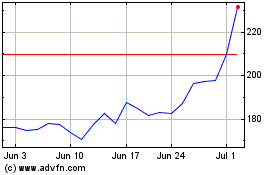Tesla's Losses Widen on Lower-Than-Expected Deliveries
May 04 2016 - 7:18PM
Dow Jones News
By Mike Ramsey
Tesla Motors Inc. said on Wednesday it would ramp up annual
production to a half-million vehicles two years earlier than
planned, but the electric-car maker will be doing so without two
top manufacturing executives.
The Palo Alto, Calif., company nearly doubled its first-quarter
loss compared with the same period a year ago, even as sales of its
pricey sedan and sport-utility vehicle continued to climb. Tesla
abandoned a plan to generate positive cash flow in 2016 as it pours
money into its coming Model 3, a $35,000 and up car that it now
says will help it sell 500,000 cars by 2018.
The company aims to start churning out Model 3s in the second
half of next year. It has a goal of building a total of between
100,000 and 200,000 by year end.
Tesla has struggled to build its current products on time and
free of glitches. Problems with the doors and seat latches on the
$81,000 and up Model X SUV over the last six months have dented the
company's image.
On Wednesday, Tesla said two high-ranking executives involved
with output -- Production Vice President Greg Reichow and
Manufacturing Vice President Josh Ensign -- have already left or
will be leaving the company.
Mr. Reichow had been with the car maker since 2011 and had run
its powertrain engineering before taking over production. He will
stay until a replacement comes on board, Tesla said. Mr. Ensign
headed manufacturing and has left the company.
The departures aren't altogether surprising. Founded in 2003,
Tesla has lost a number of executives over the past year as rival
electric-car startups and technology companies recruit its
employees. Among recent departures: Vice President of Worldwide
Finance Michael Zanoni, and Jim Chen, its assistant vice president
of regulatory affairs.
"Tesla is going to be hell-bent on becoming the best
manufacturer on earth. Thus far, I think we've done a good job on
design and technology on our products," Chief Executive Elon Musk
said in a conference call with investors on Wednesday. "The key
thing we need to do in the future is to also be a leader in
manufacturing. It's a thing we need to obviously solve if we are
going to scale and scale rapidly."
In a letter to shareholders, Mr. Musk reiterated a target of
selling between 80,000 and 90,000 vehicles this year despite the
first quarter shortfall. He also said "increasing production five
fold over the next two years will be challenging and will likely
require some additional capital."
Wall Street analysts have been closely watching the company's
cash burn, and some have speculated it would need to sell addition
shares to finance its production push.
Tesla's new production goal comes after nearly 400,000 people
placed orders for the Model 3, which is projected to go at least
215 miles on a charge. Reservations required $1,000 refundable
deposits and produced hundreds of millions of dollars in new funds
during the quarter. Those monies helped bolster Tesla's finances
and gave it confidence to pull forward its production plans,
officials said.
Mr. Musk, on the call with reporters, estimated Tesla's 2020
production would be 1 million vehicles. Tesla, however, missed its
delivery forecast in its first quarter because of a parts shortage
for the Model X and other production issues.
It shipped 14,820 vehicles, fewer than the 16,000 cars it had
pledged to deliver. It also borrowed $430 million from its line of
credit in the quarter, allowing it to increase its cash balance to
$1.44 billion at the end of March.
The company used some of the $1,000 deposits submitted for Model
3 orders to help repay $350 million on its credit line after the
quarter ended.
Tesla had promised to start generating cash in 2016, but to ramp
up production of the Model 3 more quickly it abandoned that pledge
and said its capital spending now may rise to $2.25 billion, up
from the $1.5 billion forecast earlier.
Tesla reported a first quarter loss of $283 million, or $2.13 a
share, as the lower-than-expected deliveries hurt revenues. On an
adjusted basis, Tesla lost 57 cents a share, slightly less than the
58-cent loss average compiled by Thomson Reuters.
Revenue for the quarter rose 22% from a year earlier to $1.15
billion and its gross margin declined, excluding the $57 million it
was paid for selling pollution credits to other car makers.
Write to Mike Ramsey at michael.ramsey@wsj.com
(END) Dow Jones Newswires
May 04, 2016 19:03 ET (23:03 GMT)
Copyright (c) 2016 Dow Jones & Company, Inc.
Tesla (NASDAQ:TSLA)
Historical Stock Chart
From Aug 2024 to Sep 2024

Tesla (NASDAQ:TSLA)
Historical Stock Chart
From Sep 2023 to Sep 2024
